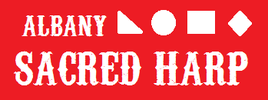About Sacred Harp
“Haunting ancient harmonies and lyrics that make Ralph Stanley’s ‘I’m a Man of Constant Sorrow’ sound like a jingle by comparison.” —New York Times
“The soaring magnificence of Southern Sacred Harp: a robust, harmonically intricate blend of country joy and unearthly drone.” —Rolling Stone
“The heavy metal music of the nineteenth century” —Judy Hauff
“Get enough people singing weird harmonies at the top of their voices and you start feeling a little sorry for the devil.” —Washington City Paper
B.F. White and E.J. King's Sacred Harp (first published 1844, revisions through 1991) is a goldmine of wonderful minor and major folk hymns, rousing camp meeting songs, and some more complex fuguing tunes and anthems. The harmonies are usually in an older "lonesome" style than later styles such as gospel.

The music is printed in a four-shape shape note notation first seen in a book published right here in Albany, N.Y., in 1802 (The Easy Instructor, which contains some not-so-easy songs like this). Each shape corresponds to a syllable (fa, sol, la, mi) and refers to the degree of the major or minor scale being sung. We practice the tune by singing these syllables according to the shapes before we sing the poetry. The shape notes enable people who don't know how to read music to learn to sight-sing. Singers do not have to know what key the song is in or the names of the pitches (F, G, A, etc.) in order to sing their parts correctly.
Over the 19th century, this music, already considered old-fashioned in its original New England home territory, spread to the southern and western frontier. Some Baptist groups that resisted the introduction of musical instruments into religious song (centered around Alabama and Georgia) continue the singing tradition today and kept it alive long enough for it to spread more widely in the 20th-century folk revival. Today, there are very active communities of Sacred Harp singers throughout the U.S. and Canada and even in Europe (Ireland, U.K., Poland, Germany) and beyond.
The songs are traditionally sung at all-day singings and singing conventions (in addition to practice singings and family singings), loudly (but with rhythmic accent), joyfully, and without vibrato, in the style of traditional southern singers.
The best way to learn everything you need to know about Sacred Harp singing is to come to an all-day singing (to get the full experience) and to your local practice singing! There are no auditions, rehearsals, or performances, just singing for joy when you wish to do so.
Over the 19th century, this music, already considered old-fashioned in its original New England home territory, spread to the southern and western frontier. Some Baptist groups that resisted the introduction of musical instruments into religious song (centered around Alabama and Georgia) continue the singing tradition today and kept it alive long enough for it to spread more widely in the 20th-century folk revival. Today, there are very active communities of Sacred Harp singers throughout the U.S. and Canada and even in Europe (Ireland, U.K., Poland, Germany) and beyond.
The songs are traditionally sung at all-day singings and singing conventions (in addition to practice singings and family singings), loudly (but with rhythmic accent), joyfully, and without vibrato, in the style of traditional southern singers.
The best way to learn everything you need to know about Sacred Harp singing is to come to an all-day singing (to get the full experience) and to your local practice singing! There are no auditions, rehearsals, or performances, just singing for joy when you wish to do so.
Frequently asked questions
There are several useful collections of Sacred Harp FAQ's and introductory information:
Feel free to contact us with your questions!
- First Time at a Sacred Harp Singing? handout adapted from Lisa Grayson's full-length Beginner's Guide
- Can't make it to Camp Fasola in Alabama for singing school? Attend Virtual Camp Fasola via this 22-hour YouTube playlist, including everything from rudiments for beginners to historical reminiscences and classes on more specific topics.
- FAQ from our singing friends in Sheffield and South Yorkshire, U.K.
- FAQ from the Pacific Northwest Sacred Harp Singers
- Overview of Sacred Harp singing by Steven Sabol
- Five Things Sacred Harp Isn't by Matt Hinton
Feel free to contact us with your questions!
